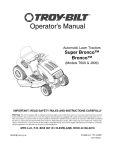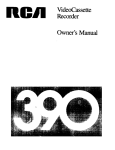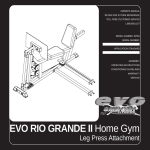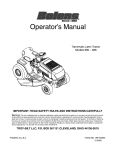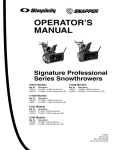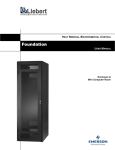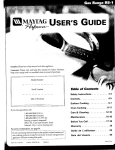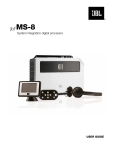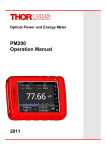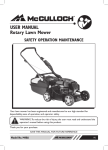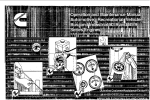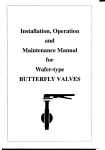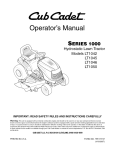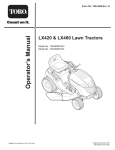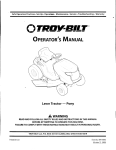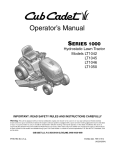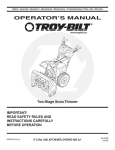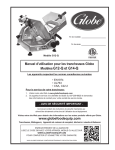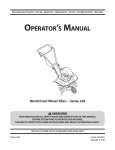Download Operator`s Manual
Transcript
®
Operator's Manual
Lawn Tractor Model
N779--Pony
IMPORTANT:
READ SAFETY RULES AND INSTRUCTIONS
®
CAREFULLY
Warning:
This unit is equipped with an internal combustion engine and should not be used on or near any unimproved forest-covered,
brush-covered or grass-covered land unless the engine's exhaust system is equipped with a spark arrester meeting applicable local or
state laws (if any). If a spark arrester is used, it should be maintained in effective working order by the operator. In the State of California
the above is required by law (Section 4442 of the California Public Resources Code). Other states may have similar laws. Federal laws
apply on federal lands. A spark arrester for the muffler is available through your nearest engine authorized service dealer or contact the
service department, P.O. Box 361131 Cleveland, Ohio 44136-0019.
TROY-BILT
PRINTED IN U.S.A.
LLC, P.O. BOX 361131 CLEVELAND,
OHIO 44136-0019
FORM NO. 769-01543
(11/22/2004)
TABLEOFCONTENTS
Content
Customer
Support
ImportantSafeOperationPractices
SlopeGauge
TractorSet-Up
KnowYourLawnTractor
Operating
YourLawnTractor
MakingAdjustments
Content
Maintaining Your Lawn Tractor
Service
Page
2
3
7
8
10
13
17
Page
19
21
Off Season Storage
Attachments & Accessories
Troubleshooting
Warranty
25
25
26
Back Cover
FINDINGMODELNUMBER
This Operator's Manual is an important part of your new lawn tractor. It will help you assemble, prepare and
maintain the unit for best performance. Please read and understand what it says.
Before you start assembling your new equipment, please locate the model plate under the seat of the
tractor and copy the information in the space provided below. A sample model plate is also given below.
This information will be necessary to use the manufacturer's web site and/or help from the Customer
Support Department or an authorized service dealer.
Copy the model number here:
Copy the serial number here:
TROY-BJLT
P. O. BOX
w_.troybJJt.com
_
LLC
361131
CLEVELANl, OH44136
330-558-7220
866-84@-648_
CUSTOMER
SUPPORT
Pleasedo NOTretl/m the unit to theretailer from where it waspurchased, withoutfirst contactingCustomerSupport.
If you have difficulty assembling this product or have any questions regarding the controls, operation or
maintenance of this unit, you can seek help from the experts. Choose from the options below:
Visit troybilt.com
for many useful suggestions. Click on Customer Support button and you will
get the four options reproduced here. Click on the appropriate button and help is immediately
available.
4t:_
mo_Jse)=cllc_< _:_wk<?y.
lee_l
alltl
IO(:II
oliz@
"_u
_itel;_t_llt
IIIililI11.1;
I s
i_{iie
!/eli
_0 fillll
ili _@III
ill_iI+
_ (.6_oR
II{_l@ll
i
als Or_tine
_ll
Ill
le_el
I moJel
}devils
To reach the Customer Support Line, please call 1-866-840-6483 or 1-330-558-7220.
En
ine
The engine manufacturer is responsible for all engine-related issues with regards to
3erformance, power-rating, specifications, warranty and service. Please refer to the engine
manufacturer's Owner's/Operator's Manual for more information.
SECTION1: IMPORTANT
SAFEOPERATION
PRACTICES
WARNING:
This symbol points out important safety instructions which, if not followed, could endanger
the personal safety and/or property of yourself and others. Read and follow all instructions in this manual
before attempting to operate this machine. Failure to comply with these instructions may result in personal
injury. When you see this symbol--heed its warning.
DANGER:
This machine was built to be operated according to the rules for safe operation in this manual. As with any type of power equipment, carelessness or error on the part of the operator can result in
serious injury. This machine is capable of amputating hands and feet and throwing objects. Failure to
observe the following safety instructions could result in serious injury or death.
California
,_
Proposition
or
emit chemicals
to the
Stateof of
cancervehicle
and birth
defects
WARNING:
Engineknown
exhaust,
some
its California
constituents,to cause
and certain
components
reproductive harm.
GENERALOPERATION
1.
Read, understand, and follow all instructions on the
machine and in the manual(s) before attempting to
assemble and operate. Keep this manual in a safe
place for future and regular reference and for
ordering replacement parts.
2.
Be familiar with all controls and their proper
operation. Know how to stop the machine and
disengage them quickly.
Never allow children under 14 years old to operate
this machine. Children 14 years old and over
should read and understand the operation
instructions and safety rules in this manual and
should be trained and supervised by a parent.
Never allow adults to operate this machine without
proper instruction.
To help avoid blade contact or a thrown object
injury, keep bystanders, helpers, children and pets
at least 75 feet from the machine while it is in
operation. Stop machine if anyone enters the area.
3.
4.
5.
6.
7.
65 Warning:
Thoroughly inspect the area where the equipment
is to be used. Remove all stones, sticks, wire,
bones, toys, and other foreign objects which could
be picked up and thrown by the blade(s). Thrown
objects can cause serious personal injury.
Plan your mowing pattern to avoid discharge of
material toward roads, sidewalks, bystanders and
the like. Also, avoid discharging material against a
wall or obstruction which may cause discharged
material to ricochet back toward the operator.
8.
Always wear safety glasses or safety goggles
during operation and while performing an
adjustment or repair to protect your eyes. Thrown
objects which ricochet can cause serious injury to
the eyes.
9.
Wear sturdy, rough-soled work shoes and closefitting slacks and shirts. Loose fitting clothes and
jewelry can be caught in movable parts. Never
operate this machine in bare feet or sandals.
orcontain
other
10. Be aware of the mower and attachment discharge
direction and do not point it at anyone. Do not
operate the mower without the discharge cover or
entire grass catcher in its proper place.
11. Do not put hands or feet near rotating parts or
under the cutting deck. Contact with the blade(s)
can amputate hands and feet.
12. A missing or damaged discharge cover can cause
blade contact or thrown object injuries.
13. Stop the blade(s) when crossing gravel drives,
walks, or roads and while not cutting grass.
14. Watch for traffic when operating near or crossing
roadways. This machine is not intended for use on
any public roadway.
15. Do not operate the machine while under the
influence of alcohol or drugs.
16. Mow only in daylight or good artificial light.
17. Never carry passengers.
18. Disengage blade(s) before shifting into reverse.
Back up slowly. Always look down and behind
before and while backing to avoid a back-over
accident.
19. Slow down before turning. Operate the machine
smoothly. Avoid erratic operation and excessive
speed.
20. Disengage blade(s), set parking brake, stop engine
and wait until the blade(s) come to a complete stop
before removing grass catcher, emptying grass,
unclogging chute, removing any grass or debris, or
making any adjustments.
21. Never leave a running machine unattended. Always
turn off blade(s), place transmission in neutral, set
parking brake, stop engine and remove key before
dismounting.
22. Use extra care when loading or unloading the
machine into a trailer or truck. This unit should not
be driven up or down ramp(s), because the unit
could tip over, causing serious personal injury. The
unit must be pushed manually on ramp(s) to load or
unload properly.
23. Mufflerandenginebecomehotandcancausea
burn.Donottouch.
24. Checkoverhead
clearances
carefullybeforedriving
underlowhangingtreebranches,
wires,door
openingsetc.,wheretheoperatormaybestruckor
pulledfromtheunit,whichcouldresultinserious
injury.
25. Disengage
allattachment
clutches,depressthe
brakepedalcompletely
andshiftintoneutralbefore
attempting
to startengine.
26. Yourmachineis designedtocutnormalresidential
grassofa heightnomorethan10".Donotattempt
tomowthroughunusually
tall,drygrass(e.g.,
pasture)orpilesofdryleaves.Drygrassor leaves
maycontacttheengineexhaustand/orbuildupon
themowerdeckpresenting
a potentialfirehazard.
27. Useonlyaccessories
andattachments
approved
forthismachinebythemachinemanufacturer.
Read,understand
andfollowallinstructions
provided
withtheapproved
accessory
or
attachment.
28. Dataindicatesthatoperators,
age60yearsand
above,areinvolvedina largepercentage
ofriding
mower-related
injuries.Theseoperators
should
evaluatetheirabilitytooperatetheridingmower
safelyenoughtoprotectthemselves
andothers
fromseriousinjury.
29. If situations
occurwhicharenotcoveredinthis
manual,usecareandgoodjudgment.Contactan
authorized
MTDServiceDealerforassistance.
4.
SLOPE
7.
OPERATION
Slopes are a major factor related to loss of control and
tip-over accidents which can result in severe injury or
death. All slopes require extra caution. If you cannot
back up the slope or if you feel uneasy on it, do not mow
it.
For your safety, use the slope gauge included as part of
this manual to measure slopes before operating this
unit on a sloped or hilly area. If the slope is greater than
15 degrees as shown on the slope gauge, do not
operate this unit on that area or serious injury could
result.
DO:
1.
2.
3.
Mow up and down slopes, not across. Exercise
extreme caution when changing direction on
slopes.
Watch for holes, ruts, bumps, rocks, or other
hidden objects. Uneven terrain could overturn the
machine. Tall grass can hide obstacles.
Use slow speed. Choose a low enough speed
setting so that you will not have to stop or shift while
on the slope. Tires may lose traction on slopes
even though the brakes are functioning properly.
Always keep machine in gear when going down
slopes to take advantage of engine braking action.
5.
6.
7.
Follow the manufacturer's recommendations for
wheel weights or counterweights to improve
stability.
Use extra care with grass catchers or other
attachments. These can change the stability of the
machine.
Keep all movement on the slopes slow and gradual.
Do not make sudden changes in speed or direction.
Rapid engagement or braking could cause the front
of the machine to lift and rapidly flip over backwards
which could cause serious injury.
Avoid starting or stopping on a slope. If tires lose
traction, disengage the blade(s) and proceed
slowly straight down the slope.
DO NOT:
1.
2.
3.
4.
5.
6.
Do not turn on slopes unless necessary; then, turn
slowly and gradually downhill, if possible.
Do not mow near drop-offs, ditches or
embankments. The mower could suddenly turn
over if a wheel is over the edge of a cliff, ditch, or if
an edge caves in.
Do not try to stabilize the machine by putting your
foot on the ground.
Do not use a grass catcher on steep slopes.
Do not mow on wet grass. Reduced traction could
cause sliding.
Do not shift to neutral and coast downhill. Overspeeding may cause the operator to lose control of
the machine resulting in serious injury or death.
Do not tow heavy pull behind attachments (e.g.
loaded dump cart, lawn roller, etc.) on slopes
greater than 5 degrees. When going down hill, the
extra weight tends to push the tractor and may
cause you to loose control. (e.g. tractor may speed
up, braking and steering ability are reduced,
attachment may jack-knife and cause tractor to
overturn).
CHILDREN
Tragic accidents can occur if the operator is not
alert to the presence of children. Children are often
attracted to the machine and the mowing activity.
They do not understand the dangers. Never
assume that children will remain where you last
saw them.
a.
b.
c.
d.
Keep children out of the mowing area and in
watchful care of a responsible adult other
than the operator.
Be alert and turn machine off if a child enters
the area.
Before and while backing, look behind and
down for small children.
Never carry children, even with the blade(s)
shut off. They may fall off and be seriously
injured or interfere with safe machine
operation.
e. Useextremecarewhenapproaching
blind
corners,doorways,
shrubs,treesor other
objectsthatmayblockyourvisionofachild
whomayrunintothemachine.
f. Toavoidback-overaccidents,always
g.
Keep children away from hot or running
engines. They can suffer burns from a hot
muffler.
i.
j.
Remove key when machine is unattended to
prevent unauthorized operation.
Never allow children under 14 years old to operate
the machine. Children 14 years old and over should
read and understand the operation instructions and
safety rules in this manual and should be trained
and supervised by a parent.
2.
Tow only with a machine that has a hitch designed
for towing. Do not attach towed equipment except
at the hitch point.
Follow the manufacturers recommendation for
3.
weight limits for towed equipment and towing on
slopes.
Never allow children or others in or on towed
4.
5.
6.
g.
h.
TOWING
1.
f.
disengage the cutting blade(s) before
shifting into reverse. The "Reverse
Caution Mode" should not be used when
children or others are around.
h.
9.
e.
equipment.
On slopes, the weight of the towed equipment may
cause loss of traction and loss of control.
Travel slowly and allow extra distance to stop.
Do not shift to neutral and coast downhill.
SERVICE
To avoid personal injury or property damage
use extreme care in handling gasoline. Gasoline is
extremely flammable and the vapors are explosive.
Serious personal injury can occur when gasoline is
spilled on yourself or your clothes which can ignite.
Wash your skin and change clothes immediately.
a. Use only an approved gasoline container.
b. Never fill containers inside a vehicle or on a
truck or trailer bed with a plastic liner. Always
place containers on the ground away from
your vehicle before filling.
c. When practical, remove gas-powered
equipment from the truck or trailer and refuel
it on the ground. If this is not possible, then
refuel such equipment on a trailer with a
portable container, rather than from a
gasoline dispenser nozzle.
d. Keep the nozzle in contact with the rim of the
fuel tank or container opening at all times
until fueling is complete. Do not use a nozzle
lock-open device.
Never remove gas cap or add fuel while the
engine is hot or running. Allow engine to cool
at least two minutes before refueling.
Never over fill fuel tank. Fill tank to no more
than Y2inch below bottom of filler neck to
allow space for fuel expansion.
Replace gasoline cap and tighten securely.
If gasoline is spilled, wipe it off the engine
and equipment. Move unit to another area.
Wait 5 minutes before starting the engine.
k. To reduce fire hazards, keep machine free of
grass, leaves, or other debris build-up. Clean
up oil or fuel spillage and remove any fuel
soaked debris.
I. Never store the machine or fuel container
inside where there is an open flame, spark or
pilot light as on a water heater, space heater,
furnace, clothes dryer or other gas
appliances.
m. Allow a machine to cool at least 5 minutes
before storing.
GENERAL SERVICE:
1.
2.
3.
SAFE HANDLING OF GASOLINE:
1.
Extinguish all cigarettes, cigars, pipes and
other sources of ignition.
Neverfuel machine indoors.
4.
5.
6.
7.
Never run an engine indoors or in a poorly
ventilated area. Engine exhaust contains carbon
monoxide, an odorless, and deadly gas.
Before cleaning, repairing, or inspecting, make
certain the blade(s) and all moving parts have
stopped. Disconnect the spark plug wire and
ground against the engine to prevent unintended
starting.
Periodically check to make sure the blades come to
complete stop within approximately (5) five
seconds after operating the blade disengagement
control. If the blades do not stop within the this time
frame, your unit should be serviced professionally
by an authorized MTD Service Dealer.
Check brake operation frequently as it is subjected
to wear during normal operation. Adjust and service
as required.
Check the blade(s) and engine mounting bolts at
frequent intervals for proper tightness. Also,
visually inspect blade(s) for damage (e.g.,
excessive wear, bent, cracked).
Replace the blade(s) with the original equipment
manufacturer's (O.E.M.) blade(s) only, listed in this
manual. "Use of parts which do not meet the
original equipment specifications may lead to
improper performance and compromise safety["
Mower blades are sharp. Wrap the blade or wear
gloves, and use extra caution when servicing them.
Keep all nuts, bolts, and screws tight to be sure the
equipment is in safe working condition.
8. Nevertamperwiththesafetyinterlocksystemor
othersafetydevices.Checktheirproperoperation
regularly.
9. Afterstrikinga foreignobject,stoptheengine,
disconnect
thesparkplugwire(s)andground
againsttheengine.Thoroughly
inspectthe
machineforanydamage.Repairthedamage
beforestartingandoperating.
10.Neverattempttomakeadjustments
or repairsto
themachinewhiletheengineis running.
11.Grasscatchercomponents
andthedischarge
coveraresubjecttowearanddamagewhichcould
exposemovingpartsor allowobjectstobethrown.
_,
Forsafetyprotection,
frequently
checkcomponents
andreplaceimmediately
withoriginalequipment
manufacturer's
(O.E.M)partsonly,listedinthis
manual."Useofpartswhichdonotmeetthe
originalequipment
specifications
mayleadto
improperperformance
andcompromise
safety!"
12. Donotchangetheenginegovernorsettingsor
over-speed
theengine.Thegovernor
controlsthe
maximumsafeoperatingspeedoftheengine.
13. Maintain
or replacesafetyandinstruction
labels,as
necessary.
14. Observeproperdisposallawsandregulations
for
gas,oil,etc.toprotecttheenvironment.
understand
follow the
warnings and instructions
in this
on the
machine.
ARNING:and YOUR
RESPONSIBILITY
Restrict the
usemanual
of this and
power
machine
to persons who read,
0
Sight and hold this level with a vertical tree...
|
_L
&i
I--
15°
SECTION3: TRACTOR
SET-UP
IMPORTANT: Your tractor is shipped with motor oil in the engine. However, you MUST check the oil level before
starting the engine and operating the tractor. Refer to the separate Briggs & Stratton Operator/Owner Manual
3acked with your tractor. Read instructions carefully.
LooseParts
AttachingTheSeat
Packaged with this Operator's Manual you'll find:
•
One Small Clamp
(726-0354)
•
One 1/4-20 x 1/2-inch Screw
(710-0599)
•
One Oil Drain Sleeve
(731-1682A)
Store the clamp and screw in a convenient place. Both
will be necessary to properly secure your tractor's wire
harness should you choose to purchase a front-end
attachment for your lawn tractor. Refer to page 25 for a
table of available attachments and accessories.
NOTE:
For shipping reasons, seats are either
fastened to the tractor seat's pivot bracket with a plastic
tie, or mounted backward to the pivot bracket. In either
case, free the seat form its shipping position and
remove the two knobs from the bottom of seat before
proceeding with applicable instructions below.
1.
Refer to page19 for information regarding the oil drain
sleeve and changing your engine oil.
2.
AttachingTheSteeringWheel
3.
Position the shoulder screws (found on the base of
the seat) inside the slot openings in the seat pivot
bracket. Figure 2.
Slide the seat slightly rearward in the seat pivot
bracket, lining up the rear slots in the pivot bracket
with the remaining two holes in the seat's base.
Select desired position for the seat, and secure with
the two knobs removed earlier. See Figure 2.
Tools RequiredForAssembly
(1) 1/2" socket wrench
1.
2.
The hardware for attaching the steering wheel has
been packed within the steering wheel, beneath
steering wheel cap. Carefully pry off the steering
wheel cap and remove the hardware.
With the wheels of the tractor pointing straight
forward, place the steering wheel over the steering
shaft.
3.
Place the washer (with the cupped side down) over
the steering shaft and secure with the hex bolt. See
Figure 1.
4.
Place the steering wheel cap over the center of the
steering wheel and push downward until it "clicks"
into place.
Knobs
Shoulder
Screws
Opening
in Slot
Figure 2
GasandOilFill-up
The gasoline tank is located under the hood and has a
capacity of 1-1/2 gallons. Do not overfill.
handling gasoline.
extremely
WARNING:
Use Gasoline
extreme iscare
when
flammable and the vapors are explosive.
Never fuel machine indoors or while the
engine
is hot or running.
Extinguish
cigarettes, cigars, pipes, and other sources of
ignition.
j_
Figure 1
Service the engine with gasoline and oil as instructed in
the separate Briggs & Stratton Operator/Owner Manual
packed with your tractor. Read instructions carefully.
Tire Pressure
ShippingBraceRemoval
,i_
engine is off, remove
the ignition
key, mower's
and set
WARNING:
Make sure
the riding
the parking brake before removing the
shipping brace.
Locate the shipping brace and accompanying
warning tag found on the right side of the mower,
between the discharge chute and the cutting deck.
See Figure 3.
any circumstances
is 30
Equalunder
tire
WARNING:
Maximum
tire psi.
pressure
pressure should be maintained at all times.
,_
The tires on your unit may be over-inflated for shipping
purposes. Reduce the tire pressure before operating
the tractor. Recommended operating tire pressure is
approximately 10 p.s.i for the rear tires & 14 p.s.i, for the
front tires. Check sidewall of tire for maximum p.s.i.
Attachingthe BatteryCables
NOTE:
The positive battery terminal is marked Pos.
(÷). The negative battery terminal is marked Neg. (-).
•
The positive cable (heavy red wire) is secured to
the positive battery terminal (+) with a hex bolt and
hex nut at the factory. Make certain that the rubber
boot covers the terminal to help protect it from
corrosion.
•
Remove the hex bolt and wing nut from the
negative cable.
Remove the black plastic cover, if present, from the
negative battery terminal and attach the negative
cable (heavy black wire) to the negative battery
terminal (-) with the bolt and wing nut.
Make certain the hold-down strap is in position over
the battery, securing it in place. See Figure 4.
•
WarningTag
•
Figure 3
While holding the discharge chute with your left
hand, remove the shipping brace with your right
hand by grasping it between your thumb and index
finger and rotating it clockwise.
RubberBoot
WARNING:
The shipping brace, used for
packaging purposes only, must be removed
and discarded before operating your riding
mower.
i
WARNING:
The mowing deck is capable of
throwing objects. Failure to operate the riding
mower without the discharge cover in the
proper operating position could result in
serious
personal
injury and/or property
damage.
NOTE:
If the battery is put into service after the date
shown on top of battery, charge the battery as
instructed on page 22 of this manual prior to operating
the tractor.
SECTION4: KNOWYOURLAWNTRACTOR
D
E
A
\
B
f
C
{
, ...........................
iT ¸¸_
G
Figure 5
A
B
C
Speed Control Lever/Parking
Clutch-brake Pedal
Shift Lever
D
Throttle Control Lever
Brake
E
F
G
Ignition Switch Module
Deck Lift Lever
PTO (Blade Engage) Lever
NOTE: Any reference in this manual to the RIGHT or LEFT side of the tractor is observed from operator's position.
lO
ThrottleControl
Parking Brake
The throttle control lever is
located on the right side of
the tractor's dash panel. This
lever controls the speed of
the engine and, when
pushed all the way forward,
the choke control also. When
set in a given position, the
throttle will maintain a
To set the parking brake, fully depress the clutch-brake
pedal. Move the speed control lever all the way down
and into the parking brake position. Release the clutchbrake pedal to allow the parking brake to engage.
uniform engine speed.
NOTE:
To release the parking brake, depress the clutch-brake
pedal and move the speed control lever out of the
notches to the desired position. Release the speed
control lever and the clutch-brake pedal.
The parking brake must be set if the operator
leaves the seat with the engine running or the engine
will automatically shut off.
IMPORTANT:When operating the tractor with the cutting
deck engaged, be certain that the throttle lever is
always in the FAST (rabbit) position.
IMPORTANT: Always set the parking brake when
leaving the tractor unattended.
ChokeControl
Shift Lever
Moving the throttle lever all the way forward activates
the engine's choke control. Activating the choke control
closes the choke plate on the carburetor and aids in
starting the engine. Refer to StartingThe Engineon page
1 4 of this manual for detailed starting instructions.
SpeedControlLever
The speed control lever, located on
the left side of the tractor's dash
The shift lever is located on the left side of the fender
and has three positions, FORWARD, NEUTRAL and
REVERSE. The brake pedal must be depressed and
the tractor must not be in motion when the moving shift
lever. See Figure 6.
O
console, allows you to regulate the
ground speed of the lawn tractor. To
use, depress the clutch-brake pedal
and move the lever out of the parking
brake notch and forward to increase
:SRWARD
m
the tractor's ground speed. When a
desired speed has been reached,
release the lever into an appropriate
notch to maintain that speed.
To slow the tractor's ground speed,
depress the clutch-brake pedal and
move the speed control lever
rearward and release it into a notch.
_UE'mAL
Shift Knob
PARK
BRAKE
_EVERSE
Clutch-brakePedal
Figure 6
The clutch-brake pedal is located on the left side of the
lawn tractor, along the running board. Depress the
clutch-brake pedal part way down when slowing the
tractor by changing speeds (Refer to SpeedControlLever).
Depress the pedal all the way down to engage the disc
brake and bring the tractor to a complete stop.
IMPORTANT: Never force the shift lever. Doing so may
result in serious damage to the tractor's transmission.
NOTE:
The pedal must be depressed to start the
engine. Refer to SafetyinterlockSwitcheson page 13.
11
DeckLiftLever
Found on your tractor's right fender,
the deck lift lever is used to change
the height of the cutting deck. To use,
move the lever to the left, then place
in the notch best suited for your
application.
IgnitionSwitch Module
WARNING:
Never leave a running machine
unattended. Always disengage PTO, move
shift lever into neutral position, set parking
brake, stop engine and remove key to prevent
unintended starting.
0
ot
Z
To start the engine, insert the key into the ignition
switch and turn clockwise to the START position.
Release the key into the NORMAL MOWING MODE
position once the engine has fired.
PTO(BladeEngage)Lever
Found on the tractor's right fender,
the PTO (blade engage) lever is used
to engage power to the cutting deck
or other (separately available)
attachments. To operate, move the
lever all the way forward. Moving the
lever all the way rearward into the
PTO OFF position disengages power
to the cutting deck/attachment.
NOTE:
The PTO (blade engage)
lever must be in the disengaged
(PTO OFF) position when starting the
engine.
O
To stop the engine, turn the ignition key
counterclockwise to the OFF position. See Figure 7.
o3
m
m
Z
Normal
DrMng Mode
°4
Stop
Position
Start
Position
-'5
O
Figure 7
IMPORTANT: Prior to operating the tractor, refer to both
SafetyInterleckSwitcheson page 13 and StartingThe Engine
on page 14 of this manual for detailed instructions
regarding the Ignition Switch Module and operating the
tractor in REVERSE CAUTION MODE.
12
SECTION5: OPERATING
YOURLAWNTRACTOR
3.
SafetyInterlockSwitches
This tractor is equipped with a safety interlock system
for the protection of the operator. If the interlock system
should ever malfunction, do not operate the tractor.
Contact an authorized Troy-Bilt service dealer.
•
•
•
•
•
,_
4.
The safety interlock system prevents the engine
from cranking or starting unless the parking brake is
engaged, and the PTO (Blade Engage) knob (or
lever) is in the disengaged (OFF) position.
The engine will automatically shut off if the operator
leaves the seat before engaging the parking brake.
The engine will automatically shut off if the operator
leaves the tractor's seat with the PTO (Blade
Engage) lever in the engaged (ON) position,
regardless of whether the parking brake is
engaged.
The engine will automatically shut off if the operator
engages the PTO with the parking brake ON.
With the ignition key in the NORMAL MOWING
position, the engine will automatically shut off if the
PTO (Blade Engage) lever is moved into the
engaged (ON) position with the shift lever in
Reverse.
5.
6.
IMPORTANT: The REVERSE CAUTION MODE will
remain activated until:
a.
b,
Indicator
Light
interlock
is operate
malfunctioning,
WARNING:system
Do not
the tractor ifThis
the
system was designed for your safety and
protection,
Use extreme
caution
The key is placed in either the NORMAL
MOWING position or STOP position,
The operator engages the parking brake by
fully depressing the brake pedal and holding
it down while gently pushing the parking
brake button inward,
O_IILOREN
AROUND
REVERSEPUSH
BUTTON
Start
Position
while
operating the tractor in the REVERSE
CAUTION MODE. Always look down and
behind before and while backing, Do not
operate the tractor when children or others
are around. Stop the tractor immediately if
someone enters the area.
Figure 8
The REVERSE CAUTION MODE position of the key
switch module allows the tractor to be operated in
reverse with the blades (PTO) engaged,
Engagingthe Parking Brake
IMPORTANT:
To engage the parking brake:
Mowing in reverse is not recommended.
To use the REVERSE CAUTION MODE:
•
Fully depress the brake pedal and hold it down with
your foot while gently pushing the parking brake
button inward.
•
Hold the parking brake button in while removing
your foot from the brake pedal.
IMPORTANT:The operator MUST be seated in the
tractor seat,
1.
2.
Reverse
PushButton
Reverse
- CautionMode
Position
Stop
Position
ReverseCautionMode
WARNING:
Depress the REVERSE PUSH BUTTON (Orange,
Triangular Button) at the top, right corner of the key
switch module. The red indicator light at the top, left
corner of the key switch module will be ON while
activated. See Figure 8.
Once activated (indicator light ON), the tractor can
be driven in reverse with the cutting blades (PTO)
engaged.
Always look down and behind before and while
backing to make sure no children are around.
After resuming forward motion, return the keyto the
NORMAL MOWING position.
Start the engine as previously instructed in this
Operator's Manual.
Turn the key from the NORMAL MOWING
(Green) position to the REVERSE CAUTION
MODE (Yellow) position of the key switch module.
See Figure 8.
•
Once engaged, the parking brake button and the
brake pedal will lock in the "down" position.
To disengage the parking brake:
•
13
Slightly depress the brake pedal.
IMPORTANT: Do NOT hold the key in the START
position for longer than ten seconds at a time. Doing so
may cause damage to your engine's electric starter.
WARNING
AVOIDSERIOUS
INJURYORDEATH
•
•
•
•
•
•
•
•
•
•
•
•
•
GO UP AND DOWN SLOPES, NOT ACROSS.
AVOID SUDDEN TURNS.
DO NOT OPERATE THE UNIT WHERE IT COULD SLIP OR TIR
IF MACHINE STOPS GOING UPHILL, STOP BLADE(S) AND BACK
DOWNHILL SLOWLY.
DO NOT MOW WHEN CHILDREN OR OTHERS ARE AROUND.
NEVER CARRY CHILDREN, EVEN WITH BLADES OFR
LOOK DOWN AND BEHIND BEFORE AND WHILE BACKING.
KEEP SAFETY DEVICES (GUARDS, SHIELDS, AND SWITCHES) IN
PLACE AND WORKING.
REMOVE OBJECTS THAT COULD BE THROWN BY THE BLADE(S).
KNOW LOCATION AND FUNCTION OF ALL CONTROLS.
BE SURE BLADE(S) AND ENGINE ARE STOPPED BEFORE PLACING HANDS OR FEET NEAR BLADE(S).
BEFORE
LEAVING
OPERATOR'S
POSITION,
DISENGAGE
BLADE(S),
PLACE THE SHIFT LEVER IN NEUTRAL,
ENGAGE
BRAKE LOCK, SHUT ENGINE OFF AND REMOVE KEY.
NOTE:
Do NOT leave
the throttle control
in the
CHOKE position while operating the tractor. Doing so
will result in a "rich" fuel mixture and cause the engine
to run poorly.
Stoppingthe Engine
WARNING:
If you strike a foreign object,
stop the engine, disconnect the spark plug
wire(s) and ground against the engine.
Thoroughly
inspect the machine for any
damage. Repair the damage before restarting
and operating
READOPERATOR'S
MANUAL
SettingtheCuttingHeight
If the blades are engaged, place the PTO (Blade
Engage) knob (or lever) in the disengaged (OFF)
position.
Turn the ignition key counterclockwise to the OFF
position.
Remove the key from the ignition switch to prevent
unintended starting.
Select the height position of the cutting deck by placing
the deck lift lever in any of the five different cutting
height notches on the right side of the fender. Then
adjust the deck wheels, if so equipped, so that they are
between 1A-inch and Y2-inch above the ground when the
tractor is on a smooth, flat surface such as a driveway.
,_
After the engine starts, deactivate the choke control
and place the throttle control in the FAST position.
DrivingTheTractor
from
the discharge
of the
WARNING:
Keep opening
hands and
feet cutting
away
deck.
starts,
NOTE: On models so equipped, the deck wheels are
an anti-scalp feature of the deck and are not designed
to support the weight of the cutting deck.
,i_
ex-
cessive
speed and
sudden
stops.
WARNING:
Avoid
sudden
WARNING:
Do not leave the seat of the
tractor without first placing the PTO (Blade
Engage) lever in the disengaged
(OFF)
position, depressing the brake pedal and
engaging the parking brake. If leaving the
tractor unattended, also turn the ignition key
off and remove the key.
Refer to Levelingthe Deckon page 17 of this manual for
more detailed instructions regarding various deck
adjustments.
Starting the Engine
WARNING:
,_
Always look down and behind
before and while backing up to avoid a backover accident.
interlock
is operate
malfunctioning.
WARNING:system
Do not
the tractor ifThis
the
system was designed for your safety and
protection.
NOTE: Refer to the TRACTORSET-UPon page 8 of this
manual for Gasoline and Oil fill-up instructions.
•
•
•
•
•
•
•
Insert the tractor key into the ignition switch.
Place the PTO (Blade Engage) knob (or lever) in
the disengaged (OFF) position.
Engage the tractor's parking brake.
Activate the choke control.
Depress the brake pedal to release the parking
brake and let the pedal up.
Move the throttle lever into the FAST (rabbit)
position.
Place the shift lever in either the FORWARD or
REVERSE position.
IMPORTANT: Do NOT use the shift lever to change the
direction of travel when the tractor is in motion. Always
use the brake pedal to bring the tractor to a complete
stop before shifting.
Turn the ignition key clockwise to the START
position. After the engine starts, release the key. It
will return to the ON position.
14
•
Release the parking brake by depressing the
clutch-brake pedal and positioning the speed
control lever in desired position.
DrivingOnSlopes
Refer to the SLOPEGAUGE
on page 7 to help determine
slopes where you may operate the tractor safely.
IMPORTANT: First-time operators should use speed
positions 1 or 2. Become completely familiar with the
tractor's operation and controls before operating the
tractor in higher speed positions.
•
•
WARNING:
slope in excess of 15 degrees (a rise of
approximately 2-1/2 feet every 10 feet). The
tractor could overturn and cause serious
injury.
Release clutch-brake pedal slowly to put unit into
motion.
The lawn tractor is brought to a stop by depressing
the clutch-brake pedal.
•
•
NOTE: When operating the unit initially, there will be
little difference between the highest two speeds until
after the belts have seated themselves into the pulleys
during the break-in period.
,_
•
•
position
for any
reason,
the
WARNING:
Before
leaving disengage
the operator's
blades, place the shift lever in neutral,
engage the parking brake, shut engine off
and remove the key.
•
IMPORTANT: When stopping the tractor for any reason
while on a grass surface, always
•
•
•
Mow up and down slopes, NEVER across.
Exercise extreme caution when changing direction
on slopes.
Watch for holes, ruts, bumps, rocks, or other
hidden objects. Uneven terrain could overturn the
machine. Tall grass can hide obstacles.
Avoid turns when driving on a slope. If a turn must
be made, turn down the slope. Turning up a slope
greatly increases the chance of a roll over.
Avoid stopping when driving up a slope. If it is
necessary to stop while driving up a slope, start up
smoothly and carefully to reduce the possibility of
flipping the tractor over backward.
Usingthe DeckLift Lever
Place the shift lever in neutral,
Engage the parking brake,
Shut engine off and remove the key.
To raise the cutting deck, move the deck lift lever to the
left, then place it in the notch best suited for your
application. Refer to SettingTheCuttingHeightearlier in
this section.
Doing so will minimize the possibility of having your
lawn "browned" by hot exhaust from your tractor's
running engine.
Engagingthe Blades
If unit stalls with speed control in high speed, or if unit
will not operate with speed control lever in a low speed
position, proceed as follows.
•
•
•
•
•
•
•
Do not mow on inclines with a
Engaging the PTO (Blade Engage) transfers power to
the cutting deck or other (separately available)
attachments. To engage the blades, proceed as
follows:
Place shift lever in NEUTRAL.
Restart engine.
Place speed control lever in highest speed position.
Release clutch-brake pedal fully.
Depress clutch-brake pedal.
Place speed control lever in desired position.
Place shift lever in either FORWARD or REVERSE,
and follow normal operating procedures.
•
•
•
Move the throttle control lever to the FAST (rabbit)
position.
Grasp the PTO (Blade Engage) lever and position it
all the way forward into the engaged (ON) position.
Keep the throttle lever in the FAST (rabbit) position
for the most efficient use of the cutting deck or other
(separately available) attachments
IMPORTANT: The engine will automatically shut off if the
PTO is engaged with the shift lever in position for
reverse travel with the ignition key in the NORMAL
MOWING position. Refer to SafetyInterlockSwitcheson
page 13.
15
•
Mowing
•
WARNING:
To help avoid blade contact or
a thrown object injury, keep bystanders,
helpers, children and pets at least 75 feet
from the machine while it is in operation. Stop
machine if anyone enters the area.
The following information will be helpful when using the
cutting deck with your tractor.
WARNING:
Plan your mowing pattern to
avoid discharge of materials toward roads,
sidewalks, bystanders and the like. Also,
avoid discharging material against a wall or
obstruction which may cause discharged
material to ricochet back toward the operator.
Do not cut the grass too short. Short grass invites
weed growth and yellows quickly in dry weather.
Mowing should always be done with the engine at
full throttle.
•
Under heavier conditions it may be necessary to go
back over the cut area a second time to get a clean
cut.
•
Do NOT attempt to mow heavy brush and weeds
and extremely tall grass. Your tractor is designed to
mow lawns, NOT clear brush.
•
Keep the blades sharp and replace the blades
when worn. Refer to CuttingBladeson page 22 of this
manual for proper blade sharpening instructions.
Headlights
On some models, the lamps are ON whenever the
tractor's engine is running. On other models, the lamps
are ON whenever the ignition key is moved out of the
STOP position.
Do not mow at high ground speed, especially if a
mulch kit or grass collector is installed.
For best results it is recommended that the first two
laps be cut with the discharge thrown towards the
center. After the first two laps, reverse the direction
to throw the discharge to the outside for the
balance of cutting. This will give a better
appearance to the lawn.
On all models, the lamps turn OFF when the ignition
key is moved to the STOP position.
16
SECTION6: MAKINGADJUSTMENTS
•
adjustments
engineto ismake
running,
WARNING: while
Nevertheattempt
any
except where specified in the operator's
manual.
,_
Retighten the jam nut loosened earlier after proper
adjustment is achieved.
Side to Side
Levelingthe Deck
If the cutting deck appears to be mowing unevenly, a
side to side adjustment can be performed. Adjust if
necessary as follows:
NOTE:
Check the tractor's tire pressure before
performing any deck leveling adjustments. Refer to
Tires on page 21 for information regarding tire pressure.
•
Front To Rear
•
The front of the cutting deck is supported by a stabilizer
bar that can adjusted to level the deck from front to rear.
The front of the deck should be between 1/4-inch and
3/8-inch lower than the rear of the deck. Adjust if
necessary as follows:
•
•
•
•
•
With the tractor parked on a firm, level surface,
place the deck lift lever in the top notch (highest
position) and rotate the blade nearest the discharge
chute so that it is parallel with the tractor.
Measure the distance from the front of the blade tip
to the ground and the rear of the blade tip to the
ground.
The first measurement taken should be between
1/4" and 3/8" less than the second measurement.
Determine the approximate distance necessary for
proper adjustment and proceed, if necessary.
Locate the jam nut and lock nut found on the front
side of the stabilizer bracket. See Figure 10. After
loosening the jam nut:
Tighten the lock nut to raise the front of the deck;
Loosen the lock nut to lower the front of the deck.
With the tractor parked on a firm, level surface,
place the deck lift lever in the top notch (highest
position) and rotate both blades so that they are
perpendicular with the tractor.
Measure the distance from the outside of the left
blade tip to the ground and the distance from the
outside of the right blade tip to the ground. Both
measurements taken should be equal. If they're
not, proceed to the next step.
Loosen, but do NOT remove, the hex screw on the
left deck hanger bracket. See Figure 10.
/
AdjustmentGear
Figure 10
Balance the deck by using a wrench to turn the
adjustment gear (found immediately behind the hex
cap screw just loosened) clockwise/up or
counterclockwise/down.
The deck is properly balanced when both blade tip
measurements taken earlier are equal.
Retighten the hex cap screw on the left deck
hanger bracket when proper adjustment is
achieved.
Figure 9
17
ParkingBrakeAdjustment
SeatAdjustment
To adjust the position of the seat, loosen the two knobs
on the bottom of the seat. See Figure 12. Slide the seat
forward or backward as desired. Retighten the two
knobs.
WARNING:
Never attempt to adjust the
brakes while the engine is running. Always
disengage PTO, move shift lever into neutral
position, stop engine and remove key to
prevent unintended starting.
If the tractor does not come to a complete stop when
the brake pedal is completely depressed, or if the
tractor's rear wheels can roll with the parking brake
applied, the brake is in need of adjustment. The brake
disc can be found on the right side of the transmission
in the rear of the tractor. Adjust if necessary as follows:
•
Knobs
Looking at the transmission from the right side of
the tractor, locate the compression spring and
brake disc. See Figure 11.
CompressionSpring
Figure 12
Transmission
Brake Disc
Figure 11
Loosen, but do NOT remove, the hex nut found on
the right side of the brake assembly. See Figure 11.
Re-tighten the hex nut, allowing a gap of .011"
between the brake disc and the brake puck. Use a
feeler gauge to achieve a precise measurement.
18
SECTION7: MAINTAININGYOURLAWNTRACTOR
•
_,
Remove drain plug and drain oil into a suitable
container with a capacity of no less than 64 oz.
•
Service the oil filter (if so equipped) as instructed
in the separate Briggs & Stratton Operator/Owner
Manual packed with your unit.
Perform the above steps in the opposite order after oil
has finished draining.
maintenance
repairs, disengage
WARNING: or Before
performing PTO,
any
move shift lever into neutral position, set
parking brake, stop engine and remove key to
prevent unintended starting.
Engine
•
Refer to the Briggs & Stratton Operator/Owner
Manual for engine maintenance instructions.
IMPORTANT: Refer to the Briggs & Stratton Operator/
Owner Manual packed with your unit for information
regarding the quantity and proper weight of motor oil.
Check engine oil level before each use as instructed in
the Briggs & Stratton Operator/Owner Manual packed
with your unit. Follow the instructions carefully.
Air Cleaner
Changing Engine 0il
Service the pre-cleaner, if so equipped, and cartridge/
air cleaner element as instructed in the Briggs &
Stratton Operator/Owner Manual packed with your unit.
NOTE: Depending on the engine model found on your
tractor, it maybe necessary to remove the tractor's side
panel in order to replace the oil filter (if so equipped).
Spark Plug(s)
The spark plug(s) should be cleaned and the gap reset
once a season. Spark plug replacement is
recommended at the start of each mowing season.
Refer to the Briggs & Stratton Operator/Owner Manual
for correct plug type and gap specifications.
Changing Engine 0il
For draining oil from the engine's crankcase of select
model tractors a plastic oil drain sleeve is packed with
this Operator's Manual. To drain the oil, proceed as
follows:
•
Unscrew the oil fill cap and remove the dipstick
from the oil fill tube.
•
Snap the small end of oil drain sleeve onto the oil
sump. See Figure 13.
Refill the engine with new motor oil.
Lubrication
WARNING:
inspecting,
shift lever
brake, stop
unintended
Before lubricating, repairing, or
always disengage PTO, move
into neutral position, set parking
engine and remove key to prevent
starting.
Engine
Lubricate the engine with motor oil as instructed in the
Briggs & Stratton Owner Manual packed with your unit.
Pivot Points & Linkage
Lubricate all the pivot points on the drive system,
parking brake and lift linkage at least once a season
with light oil.
Rear Wheels
The rear wheels should be removed from the axles
once a season. Lubricate the axles and the rims well
with an all-purpose grease before re-installing them.
FrontAxles
Each end of the tractor's front pivot bar may be
equipped with a grease fitting. Lubricate with a grease
gun after every 25 hours of tractor operation.
Figure 13
19
CleaningtheEngineAndDeck
Any fuel or oil spilled on the machine should be wiped
off promptly. Do NOT allow debris to accumulate
around the cooling fins of the engine or on any other
part of the machine.
IMPORTANT: The use of a pressure washer to clean
your tractor is NOT recommended. It may cause
damage to electrical components, spindles, pulleys,
bearings or the engine.
DeckWash SystemTM
A hex plug can be found on your tractor's deck surface.
See Figure 14.
HexPlug
Figure 14
This plug can be replaced with a water port to be used
as part of a separately-available deck wash system.
Use the Deck Wash System TM to rinse grass clippings
from the deck's underside and prevent the buildup of
corrosive chemicals.
NOTE: Refer to page 25 for information regarding this
and
other
separately-available
attachments
&
accessories for your tractor.
20
SECTION8: SERVICE
CuttingDeckRemoval
To remove the cutting deck, proceed as follows:
•
Place the PTO (Blade Engage) lever in the
disengaged (OFF) position.
•
Engage the parking brake.
•
Lower the deck by moving the deck lift lever into the
bottom notch on the right fender.
•
Remove the belt from around the tractor's engine
pulley and idler pulley(s). Refer to Changing
the Deck
Belton page 24 for detailed instructions. See Figure
20.
•
Looking at the cutting deck from the left side of the
tractor, locate the hair pin clip that secures the deck
support rod on the rear left side of the deck. See
Figure 15.
PTOCable
.....
Figure 16
Carefully remove the PTO cable from the rear of
the cutting deck by removing the hair pin clip which
secures it. Proceed to remove the spring from the
deck idler bracket. See •.
Gently slide the cutting deck toward the front of the
tractor allowing the hooks on the deck to release
themselves from the deck stabilizer rod.
Gently slide the cutting deck (from the right side)
out from underneath the tractor.
Tires
,_
Figure 15
•
•
•
Remove the hair pin clip that secures the deck
support rod, and carefully remove the deck support
from the deck lift arm.
inflation pressureNever
shownexceed
on the sidewall
of the
WARNING:
the maximum
t ire.
The recommended operating tire pressure is:
•
•
Repeat the above steps on the tractor's right side.
Move the deck lift lever into the top notch on the
right fender to raise the deck lift arms up and out of
the way.
Approximately 10 psi for the rear tires
Approximately 14 psi for the front tires
IMPORTANT: Refer to the tire sidewall for exact tire
manufacturer's recommended or maximum psi. Do not
overinflate. Uneven tire pressure could cause the
cutting deck to mow unevenly.
21
Battery
The battery is sealed and is maintenance-free.
levels cannot be checked.
•
•
•
Cleaning
Clean the battery by removing it from the tractor and
washing with a baking soda and water solution. If
necessary, scrape the battery terminals with a wire
brush to remove deposits. Coat terminals and exposed
wiring with grease or petroleum jelly to prevent
corrosion.
Acid
Always keep the battery cables and terminals clean
and free of corrosive build-up.
After cleaning the battery and terminals, apply a
light coat of petroleum jelly or grease to both
terminals.
BatteryFailures
Some common causes for battery failure are:
Always keep the rubber boot positioned over the
positive terminal to prevent shorting.
• freezing
• undercharging
• overcharging
• corroded connections
These failures are NOT covered by your tractor's
warranty.
IMPORTANT: If removing the battery for any reason,
disconnect the NEGATIVE (Black) wire from it's
terminal first, followed by the POSITIVE (Red) wire.
When re-installing the battery, always connect the
POSITIVE (Red) wire its terminal first, followed by the
NEGATIVE (Black) wire. Be certain that the wires are
connected to the correct terminals; reversing them
could change the polarity and result in damage to your
engine's alternating system.
Fuse
One 20 AMP fuse is installed in your tractor's wiring
harness to protect the tractor's electrical system from
damage caused by excessive amperage.
If the electrical system does not function, or your
tractor's engine will not crank, first check to be certain
that the fuse has not blown. It can be found under the
Charging
If the tractor has not been put into use for an extended
period of time, charge the battery with an automotivetype 12-volt charger for a minimum of one hour at six
amps.
,_
hood mounted behind the dash panel on the right side.
,_
gas
while charging.
Charge
in a well
WARNING:
Batteries
give battery
off an explosive
ventilated area and keep away from an open
flame or pilot light as on a water heater, space
heater, furnace, clothes dryer or other gas
appliances.
CuttingBlades
WARNING:
Be sure to shut the engine off,
remove ignition key, disconnect the spark plug
wire(s) and ground against the engine to
prevent unintended starting before removing
the cutting blade(s) for sharpening
or
replacement. Protect your hands by using
heavy gloves or a rag to grasp the cutting
blade.
Jump Starting
,_
the
battery, follow
instructions
to
WARNING:
When these
removing
or installing
prevent the screwdriver from shorting against
the frame.
IMPORTANT: Never jump your tractor's dead battery
with the battery of a running vehicle.
•
•
,_
same amperage Always
capacityuse
for replacement.
WARNING:
a fuse with the
,i_
WARNING:
spindles for cracks
Periodically
or damage,
inspectespecially
the bladeif
you
strike a foreign
immediately if damaged.
Connect end of one jumper cable to the positive
terminal of the good battery, then the other end to
the positive terminal of the dead battery.
Connect the other jumper cable to the negative
terminal of the good battery, then to the frame of
the unit with the dead battery.
object.
Replace
The blades may be removed as follows.
•
•
could cause sparking,
anduse
thethis
gasprocedure
in either
WARNING:
Failure to
battery could explode.
•
22
Remove the deck from beneath the tractor, (refer to
CuttingDeckRemovalon page 21 ) then gently flip the
deck over to expose its underside.
Place a block of wood between the center deck
housing baffle and the cutting blade to act as a
stabilizer. See Figure 17.
Use a 15/16" wrench to remove the hex flange nut
that secures the blade to the spindle assembly. See
Figure 17.
IMPORTANT: If the cutting edge of the blade has already
been sharpened to within 5/8" of the wind wing radius,
or if any metal separation is present, replace the blades
with new ones. See Figure 18.
HexFlangeNut
It is important that each cutting blade edge be ground
equally to maintain proper blade balance.
A poorly balanced blade will cause excessive vibration
and may cause damage to the tractor and result in
personal injury. The blade can be tested by balancing it
on a round shaft screwdriver. Grind metal from the
heavy side until it balances evenly.
When replacing the blade, be sure to install the blade
with the side of the blade marked "Bottom"facing the
ground when the mower is in the operating position.
IMPORTANT: Use a torque wrench to tighten the blade
spindle hex flange nut to between 70 foot-pounds and
90 foot-pounds.
SpindleAssembly
Figure 17
To properly sharpen the cutting blades,
equal amounts of metal from both ends
blades along the cutting edges, parallel
trailing edge, at a 25 ° to 30 ° angle. See
remove
of the
to the
Figure 18.
ChangingtheTransmission
DriveBelts
NOTE:
Several components must be removed and
special tools (i.e. air/impact wrench) in order to change
the tractor's drive belts. See an authorized Trey-Bflt
Service Dealer to have your drive belts replaced or
phone Customer Support as instructed on page 2 for
information on ordering a Service Manual.
Blade Separation
WornBladeEdge
WindWing
5/8"
minimum
/
SharpenEdgeEvenly
Figure 18
23
Remove the belt keeper rod from around the
engine pulley.
Insert a 3/8"-drive ratchet wrench (set to loosen)
into the square hole found in the idler bracket on
the left side of the deck's surface. See Figure 19.
ChangingtheDeckBelt
WARNING:
Be sure to shut the engine off,
remove ignition key, disconnect the spark
plug wire(s) and ground against the engine to
prevent unintended starting before removing
the belt(s).
BeltGuard
Idler Bracket
WARNING:
Avoid the possibility of a
pinching injury. Do not place your fingers on
the idler spring or between the belt and a
pulley while removing the belt.
3/8" SquareHole
All belts on your tractor are subject to wear and should
be replaced if any signs of wear are present.
IMPORTANT:The V-belts found on you r tractor are
specially designed to engage and disengage safely. A
substitute (non-OEM) V-belt can be dangerous by not
disengaging completely. For a proper working machine,
use factory approved belts.
To change or replace the deck belt on your tractor,
proceed as follows:
•
•
Figure 19
Lower the deck by moving the deck lift lever into the
bottom notch on the right fender.
Remove the belt guards by removing the selftapping screws that fasten them to the deck.
Grasp the ratchet's handle and pivot it toward the
front of the tractor to relieve tension on the belt.
With belt tension relieved, carefully remove the
belt from around the left-hand spindle pulley.
Idler Bracket
Engine Pulley
RightHandPulley
(beneathbeltguard)
Left HandPulley
(beneathbeltguard)
DeckIdlerPulleys
Figure 20
24
SECTION9: OFF-SEASON
STORAGE
Clean and lubricate the tractor as instructed in Section7:
MAINTAINING
YOURLAWNTRACTORon page 19 of this
manual before storing for an extended period.
,_
Follow the instructions in the Service, Storage &
Specifications
section of the Briggs & Stratton
Operator/Owner Manual for proper engine care prior to
storing your tractor.
approved
container
outdoors,
away into
from an
WARNING:
Drain
fuel only
an
open flame. Allow engine to cool. Extinguish
cigarettes, cigars, pipes, and other sources of
ignition prior to draining fuel.
,_
fuel
container indoors
is an open
WARNING:
Never where
store there
the machine
or
flame, spark or pilot light such as on water
heater, furnace, clothes dryer or other gas
appliance.
SECTION10: ATTACHMENTS
& ACCESSORIES
The following attachments and accessories are compatible for 700-Series Lawn Tractors. See the retailer from
which you purchased your tractor, an authorized Troy-Bilt Service Dealer or phone 1-866-840-6483 for information
regarding price and availability.
NOTE: Model Series 700 Lawn Tractors are NOT designed for use with any type of ground-engaging attachments
(e.g. tiller or plow). Use of this type of equipment WILL void the tractor's warranty.
MODEL
OEM-190-116
OEM-190-672
OEM-190-180
0EM-190-184
0EM-190-218
OEM-190-658
OEM-190-032
OEM-190-833
490-900-0024
490-900-0025
DESCRIPTION
38- and 42-inch Deck Mulch Kit
Grille Guard (mounts on front of tractor)
Twin Bagger Grass Collector
Dethatcher
Rear Wheel Weights
Tire Chains
42-inch Two-stage Snow Thrower
46-inch Front Dozer Blade
Deluxe Tractor Sunshade
Deck Wash Kit
* Not compatible with tractors equipped with a Grass Collector
25
SECTION11: TROUBLESHOOTING
Trouble
Possible
Engine fails to start
PTO engaged.
Parking brake not engaged.
Spark plug wire(s) disconnected.
Throttle control lever not in correct
starting position.
Choke not activated
Place PTO lever in disengaged (OFF) position.
Engage parking brake.
Connect wire(s) to spark plug(s).
Place throttle control in CHOKE position.
Fuel tank empty, or stale fuel.
Blocked fuel line.
Faulty spark plug.
Engine flooded.
Unit running with CHOKE applied.
Spark plug wire(s) loose.
Blocked fuel line or stale fuel.
Fill tank with clean, fresh (less than 30 days old) gas.
Clean fuel line or replace fuel filter, if so equipped.
Clean, adjust gap or replace plug.
Crank engine with throttle in FAST position.
Move the throttle control out of the CHOKE position.
Connect and tighten spark plug wire(s).
Clean fuel line; fill tank with clean, fresh (less than 30
days old) gasoline. Replace fuel filter, if so equipped.
Clear vent or replace cap if damaged.
Drain fuel tank. Refill with clean, fresh (less than 30
days old) gasoline.
Replace air cleaner cartridge/element or clean precleaner, if so equipped.
Fill crankcase with proper capacity and weight of oil.
Clean grass clippings and debris from around the
engine's cooling fins and blower housing.
Remove spark plug(s) and reset the gap.
Replace spark plug(s). Set plug(s) gap.
Engine runs erratic
Corrective
Cause(s)
Vent in gas cap plugged.
Water or dirt in fuel system.
Dirty air cleaner.
Engine overheats
Engine oil level low.
Air flow restricted.
Engine hesitates at high RPM Spark plug(s) gap too close.
Idles poorly
Spark plug(s) fouled, faulty or gap too
wide.
Dirty air cleaner.
Excessive vibration
Mower will not mulch grass
Uneven cut
Cutting blade loose or unbalanced.
Damaged or bent cutting blade.
Engine speed too low.
Wet grass.
Excessively high grass.
Dull blade.
Deck not balanced properly.
Dull blade.
Uneven tire pressure.
26
Action
Place the throttle control in CHOKE position.
Replace air cleaner cartridge/element or clean precleaner, if so equipped.
Tighten blade and spindle. Balance blade.
Replace blade.
Place throttle control in FAST (rabbit) position.
Do not mow when grass is wet; wait until later to cut.
Mow once at a high cutting height, then mow again at
desired height or make a narrower cutting swath.
Sharpen or replace blade.
Perform side-to-side deck adjustment.
Sharpen or replace blade.
Check tire pressure in all four tires.
NOTES
27
MANUFACTURER'S
LIMITED WARRANTY
FOR:
®
m
The limited warranty set forth below is given by Troy-Bilt LLC
with respect to new merchandise purchased and used in the
United States and/or its territories and possessions, and by
MTD Products Limited with respect to new merchandise
purchased and used in Canada and/or its territories and
possessions (either entity respectively, "Troy-Bilff).
"Troy-Bilt" warrants this product (excluding its normal wear
parts as described below) against defects in material and
workmanship for a period of two (2) years commencing on the
date of original purchase and will, at its option, repair or
replace, free of charge, any part found to be defective in
materials or workmanship. This limited warranty shall only
apply if this product has been operated and maintained in
accordance with the Operator's Manual furnished with the
product, and has not been subject to misuse, abuse,
commercial use, neglect, accident, improper maintenance,
alteration, vandalism, theft, fire, water, or damage because of
other peril or natural disaster. Damage resulting from the
installation or use of any part, accessory or attachment not
approved by Troy-Bilt for use with the product(s) covered by
this manual will void your warranty as to any resulting
damage.
Normal wear parts are warranted to be free from defects in
material and workmanship for a period of thirty (30) days from
the date of purchase. Normal wear parts include, but are not
limited to items such as: batteries, belts, blades, blade
adapters, grass bags, rider deck wheels, seats, snow thrower
skid shoes, friction wheels, shave plates, auger spiral rubber
and tires.
HOW TO OBTAIN SERVICE: Warranty service is available,
WITH PROOF OF PURCHASE, through your local authorized
service dealer. To locate the dealer in your area:
In the U.S.A.
Check your Yellow Pages, or contact Troy-Bilt LLC at P.O.
Box 361131, Cleveland, Ohio 44136-0019, or call 1-866-8406483 or 1-330-558-7220, or log on to our Web site at
www.troybilt.com.
In Canada
Contact MTD Products Limited, Kitchener, ON N2G 4J1, or
call 1-800-668-1238 or log on to our Web site at
www.mtdcanada.com.
This limited warranty does not provide coverage in the
following cases:
a.
b.
c.
The engine or component parts thereof. These items
may carry a separate manufacturer's warranty. Refer
to applicable manufacturer's warranty for terms and
conditions.
Log splitter pumps, valves, and cylinders have a
separate one- year warranty.
Routine maintenance items such as lubricants, filters,
blade sharpening, tune-ups, brake adjustments, clutch
adjustments, deck adjustments, and normal
m_m
deterioration of the exterior finish due to use or
d.
e.
f.
g.
h.
exposure.
Service completed by someone other than an
authorized service dealer.
Troy-Bilt does not extend any warranty for products
sold or exported outside of the United States and/or
Canada, and their respective possessions and
territories, except those sold through Troy-Bilt's
authorized channels of export distribution.
Replacement parts that are not genuine Troy-Bilt parts.
Transportation charges and service calls.
If Products are used commercially. (Troy-Biltmay
separately offer Limited Commercial Warranties on
certain select products. Ask your dealer or retailer for
details or contact Troy-Bilt Service for more
information.)
No implied warranty, including any implied warranty of
merchantability of fitness for a particular purpose,
applies after the applicable period of express written
warranty above as to the parts as identified. No other
express warranty, whether written or oral, except as
mentioned above, given by any person or entity,
including a dealer or retailer, with respect to any product,
shall bind Troy-Bilt. During the period of the warranty, the
exclusive remedy is repair or replacement of the product
as set forth above.
The provisions as set forth in this warranty provide the
sole and exclusive remedy arising from the sale. Troy-Bilt
shall not be liable for incidental or consequential loss or
damage including, without limitation, expenses incurred
for substitute or replacement lawn care services or for
rental expenses to temporarily replace a warranted
product.
Some jurisdictions do not allow the exclusion or limitation of
incidental or consequential damages, or limitations on how
long an implied warranty lasts, so the above exclusions or
limitations may not apply to you.
In no event shall recovery of any kind be greater than the
amount of the purchase price of the product sold. Alteration
of safety features of the product shall void this warranty.
You assume the risk and liability for loss, damage, or injury to
you and your property and/or to others and their property
arising out of the misuse or inability to use the product.
This limited warranty shall not extend to anyone other than
the original purchaser or to the person for whom it was
purchased as a gift.
HOW LOCAL LAWS RELATE TO THIS WARRANTY: This
limited warranty gives you specific legal rights, and you may
also have other rights that vary in different jurisdictions.
IMPORTANT: Owner must present Original
Purchase to obtain warranty coverage.
Proof of
Troy-Bilt LLC, P.O. BOX361131CLEVELAND,OHIO44136-0019; Phone:1-866-840-6483,1-330-558-7220
MTD Canada Limited - KITCHENER,ON N2G4J1; Phone1-800-668-1238




























